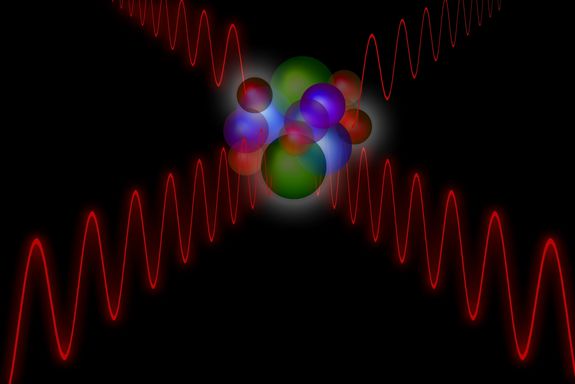Usually, light waves can pass through each other without any resistance. According to the laws of electrodynamics, two light beams can exist in the same place without influencing each other; they simply overlap. Light saber battles, as seen in science fiction films, would therefore be rather boring in reality.
Nevertheless, quantum physics predicts the effect of “light-on-light scattering”. Ordinary lasers are not powerful enough to detect it, but it has been observed at the CERN particle accelerator. Virtual particles can literally emerge from nothing for a short time, interact with the photons and change their direction. The effect is extremely small, but it must be understood precisely in order to verify particle physics theories through current high-precision experiments on muons. A team at TU Wien (Vienna) has now been able to show that a previously underestimated aspect plays an important role in this: the contribution of so-called tensor mesons. The new results have been published in the journal Physical Review Letters.
Virtual particles from nothing
When photons interact with photons, virtual particles can be created. They cannot be measured directly, as they disappear immediately. In a sense, they are constantly there and not there at the same time – quantum physics allows such superpositions of states that would be mutually exclusive according to our classical everyday understanding.
“Even though these virtual particles cannot be observed directly, they have a measurable effect on other particles,” says Jonas Mager from the Institute of Theoretical Physics at TU Wien, lead author of the study. “If you want to calculate precisely how real particles behave, you have to take all conceivable virtual particles into account correctly. That's what makes this task so difficult – but also so interesting.”
When light scatters off light, a photon may transform, for example, into an electron-positron pair. Other photons can then interact with these two particles before the electron and positron annihilate each other and become a new photon. Things become more complicated when heavier particles are created that are also subject to strong nuclear forces – for example, mesons, which consist of a quark and an antiquark.
“There are different types of these mesons,” says Jonas Mager. “We have now been able to show that one of them, the tensor mesons, has been significantly underestimated. Through the effect of light-light scattering, they influence the magnetic properties of muons, which can be used to test the Standard Model of particle physics with extreme accuracy.” Tensor mesons did appear in earlier calculations, but with very rough simplifications. In the new evaluation, not only does their contribution turn out to be much stronger than previously assumed, but it also has a different sign than previously thought, thus influencing the results in the opposite direction.
Unusual theoretical methods
This result also resolves a discrepancy that arose last year between the latest analytical calculations and alternative computer simulations. “The problem is that conventional analytical calculations can describe the strong interactions of quarks only well in limiting cases,” says Anton Rebhan (TU Wien).
The TU Wien team, on the other hand, used an unconventional method – holographic quantum chromodynamics. This involves mapping processes in four dimensions (i.e. three spatial dimensions and one time dimension) onto a five-dimensional space with gravity. Some problems can then be solved more easily in this other space, and the results are then transformed back again. “The tensor mesons can be mapped onto five-dimensional gravitons, for which Einstein's theory of gravity makes clear predictions,” explains Anton Rebhan. "We now have computer simulations and analytical results that fit well together but deviate from certain previous assumptions. We hope that this will also provide new impetus to accelerate already planned specific experiments on tensor mesons."
The standard model put to the test
These analyses are important for one of the biggest questions in physics: How reliable is the Standard Model of particle physics? This is the generally accepted quantum physical theory that describes all known types of particles and all forces of nature – except gravity.
The accuracy of the Standard Model can be investigated particularly well in a few special test cases, for example by measuring the magnetic moment of muons. For many years, scientists have been puzzling over whether certain discrepancies between theory and experiment point to “new physics” beyond the Standard Model, or whether they are simply inaccuracies or errors. The discrepancy in the muon magnetic moment has recently become much smaller – but in order to really search for new physics, the remaining theoretical uncertainties must also be understood as precisely as possible. This is exactly what the new work contributes to.
Original publication
Free version: https://arxiv.org/abs/2501.19293, opens an external URL in a new window
Contact
Dipl.-Ing. Jonas Mager
Institute of Theoretical Physics
TU Wien
+43 1 58801 13635
jonas.mager@tuwien.ac.at
Prof. Anton Rebhan
Institute of Theoretical Physics
TU Wien
+43 1 58801 13620
anton.rebhan@tuwien.ac.at
Aussender:
Dr. Florian Aigner
Corporate Communications
TU Wien
+43 664 60588 4127
florian.aigner@tuwien.ac.at
